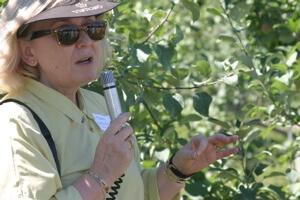On Aug. 17, 2007, UVM College of Agriculture and Life Sciences (CALS) Professor Lorraine Berkett and colleagues divulged a few early results of a new organic apple demonstration project, before a group of orchardists, researchers and the public. The new OrganicA web site has details of the news about:
- which cultivars graft best onto old 'McIntosh' trees
- that 'Honeycrisp' has some disease resistance, but, alas, "a magnet for Japanese beetles," and
- "'Ginger Gold' may turn out to be the poster child for disease among the varieties in the newly planted UVM orchards," according to Berkett.
The event was the Apple Open House at University of Vermont (UVM) Horticulture Research Center, site of the project that has been called the only significant university research effort in New England studying organic apple farming – one of only a few nationwide and one funded with a $666,000 plus USDA grant. On hand were project's researchers: UVM’s Berkett and John Hayden; UVM Extension’s Heather Darby and Robert Parsons; and pomologists Elena Garcia from the University of Arkansas and Renae Moran from the University of Maine. Also attending was Bob Paquin representing U.S. Sen. Patrick Leahy's office.
“If we can produce marketable organic apples in New England with these newer varieties, we’ll be doing something that has been very difficult to do with standard varieties,” says Berkett.
Apple growing has lagged behind other fruits and vegetables in certified organic production, because of a host of horticultural challenges – most associated with the ‘McIntosh’ variety. But recent research has identified different cultivars gaining popularity and alternative practices with strong potential to overcome apple-growing obstacles.
“It’s time that we put science to the test,” says Berkett.
In spring of 2007 she, assistant farm manager Terry Bradshaw and others, planted and grafted five apple varieties on a nearly two-acre research plot at the Horticultural Research Center. They tested two ways farmers might convert their traditional orchards to organic.
On a 190-tree ‘Mac’ and ‘Liberty’ orchard, UVM researchers cut back the 18-year-old trees and grafted the new varieties onto the trunks. Besides offering quicker orchard turnover, top-grafted trees benefit from the root system below ground.
“We will get vigorous growth and apples in their third year,” says Bradshaw. “If we start an orchard fresh, we’d lose three years of production. By doing this we get a new tree in the old orchard.”
The second plot features 240 young trees on full dwarf rootstock attached to poles with branches trained and pruned to human-sized trees that take up much less space and are easy to prune and pick.
“The training and pruning method also increases air circulation around the branches, which helps with disease control,” says Berkett.
Researchers chose five varieties that Vermont apple growers deemed the most exciting and marketable: – ‘Macoun,’ ‘Ginger Gold,’ ‘Honeycrisp,’ ‘Liberty’ and ‘Zestar!’. They closely monitor the growth and development of the trees, use horticultural and integrated pest management techniques and apply organic products when necessary.
“This research demonstrates new organic techniques and methods so growers can see these methods before they invest,” says Berkett. She estimates that establishing an orchard on a trellis system can cost up to $10,000 per acre.
The organic apple trials are also the classroom for a new organic fruit production course, student research projects and UVM Extension education. This is the first step to a certified organic farm at UVM and a UVM Extension program in organic apple production for Vermont.
